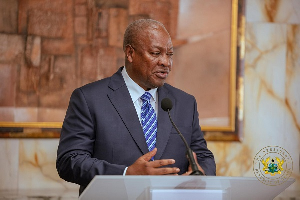A GNA feature by Hannah Asomaning
Accra, Jan. 3, GNA - In front of the Elmina Castle today lies a compass allegedly used by Christopher Columbus to discover America. Columbus, who visited Elimna on three occasions, was accompanied by Don Diego d'Azambuja on his first journey to the coast of Elmina and even saw the foundation stone of the Elmina Castle laid in 1482.
The story is told that a decade after the erection of the St. George's Castle (Fort), the celebrated Spanish explorer Christopher Columbus in the expedition that led to the discovery of America in 1492 anchored off Elmina and spent some days with the commander in the Fort (now Castle).
Around that time Elmina was a busy maritime centre and many ships docked to repair and re-set compasses and refresh the crew before continuing their explorations.
BRIEF HISTORY ABOUT ELMINA
Elmina is a 700-year-old town in the Central Region founded by Kwaa Amankwaa.
Kwaa Amankwaa stumbled on a now non-existent stream during his hunting expedition from a nearby village called Eguafo. Kwaa Amankwaa called this stream Anomansa (inexhaustible supply of water). When he brought people from Eguafo to settle in the place, the people began calling it Amankwaa Krom (Amankwaa's hamlet).
In 1471 two Portuguese sea captains Joao Santarem and Pedro d'Escobar "discovered" Amankwaa Krom as potential gold mine. Pedro d'Escobar on his return to Portugal gave an interesting account of his expedition and that aroused the interest of other Portuguese who gave impetus to enthusiasts and other adventurers to take the development of the gold trade seriously.
Elmina thus became involved in a busy maritime traffic. The town and its coastal shores became known simply in the Portuguese language as "La Mina", which means the mine, or "Costa Del Mina", which through the years became corrupted to Elmina.
To ensure continuous supply and stability in the gold trade, King Joao II of Portugal negotiated with the Chief of Elmina, Kwamena Ansah for permanent settlement.
Joseph Amissah Mensah Dadziebo, a Tour Guide in the Town, told this history to the Minister of Tourism and Modernization of the Capital City when he visited Elmina to know at first hand about a project dubbed "Elmina Heritage Project"
ELMINA HERTITAGE PROJECT.
The Elmina Heritage project, being funded by the European Union and the Netherlands Culture Fund, aims at restoring and managing the cultural heritage existing in Elmina alongside an integrated programme to improve the tourist, social and economic conditions of the town. Under the Project, provision would be made for technical and financial assistance to the town to restore historic assets as well as organize capacity building programmes for people living in the town. Nana Ato Arthur, Deputy Central Regional Minister, said other aspects of the Project were the renovation of the upper terrace of the Elmina Castle, Fort St. Jago, historic houses and improvement in tourist facilities.
Training programmes would be organized for tour guides and artisans and there would be an expansion of the Catholic Museum at St Joseph Hill.
The Central Region is the heartbeat of tourism in Ghana, and "Elmina shall become the Barcelona of Africa by 2015," the Deputy Minister said.
The project would create the right environment for the private sector to invest in hotels and the fishing industry. Mr Obetsebi-Lamptey noted that the Central Region was a major tourist centre in the world considering its visible culture and remarkable tourist sites.
"There is nothing in the Goree Island in Senegal that compares with what we have in Elmina, the more reason why it should be put on the world map," he said.
"Elmina has to be put on the world map. It is a unique small town."
Opinions of Tuesday, 3 January 2006
Columnist: GNA














